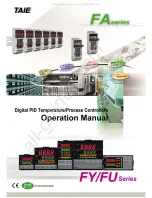
DANGER:
Never house VRLA batteries in an enclosure that does not allow dispersion of emitted
hydrogen gas.
When using a current limiting power supply such as a AC-to-DC converter, change the input
current limit using the Device Configuration Utility to prevent the CH201 from pulling more
current than what is available, thus tripping current limit protection of the converter.
VRLA batteries can provide high-surge currents. A 4.6 A solid-state circuit breaker protects the
12 VDC output terminals, but there is no fusing for inadvertent bridging of the battery terminals.
DANGER:
Accidental shorting of battery terminals by metallic objects, such as watchbands, can cause
severe burns due to rapid heating and is also a fire hazard.
VRLA battery manufacturers state that “Heat Kills Batteries.” While the operating temperature
range is –40 to 60 °C, optimum battery life occurs in the 5 to 35 °C temperature range
1
. The
CH201 offers temperature compensation of the battery charging voltage based on a temperature
measurement inside the CH201 case. The CH201 internal temperature measurement only
accurately represents battery temperature for charge voltage compensation if the battery is next
to the CH201. To overcome temperature differences, use the CH201 serial interface to input an
independently measured battery temperature for improved charging temperature compensation.
With rechargeable batteries, a charge
→
discharge
→
recharge event is termed a cycle. In
general, the most important factor for the battery service life is depth of discharge
1
. For example,
decreasing the depth of each discharge from 100% to 50% approximately doubles the number of
useful cycles available from the battery
1
.
WARNING:
Leaving a lead-acid battery in a discharged state for prolonged periods causes large sulfate
crystals (sulfation) that are detrimental to battery performance.
VRLA batteries self-discharge at approximately 3% of rated capacity per month at room
temperature
1
. A 3% of rated capacity per month self-discharge results in 100% discharge in
approximately 33 months for a battery stored at room temperature. The battery self-discharge
rate increases with higher storage temperatures.
1
Genesis Application Manual – Genesis NP and NPX Series US-NP-AM-002, June 2006.
CH201 12V Charging Regulator
2
Содержание CH201
Страница 1: ...06 2020 Copyright 2020 Campbell Scientific CSL I D 1352 ...
Страница 2: ......
Страница 4: ......
Страница 6: ......
Страница 8: ......
Страница 10: ...Appendix A Downloading an operating system 31 Table of Contents ii ...
Страница 42: ...FIGURE A 1 Downloading a new operating system CH201 12V Charging Regulator 32 ...
Страница 43: ......













































